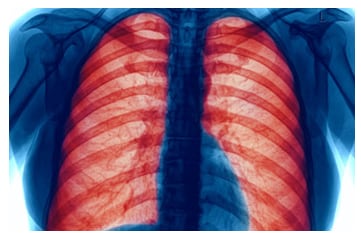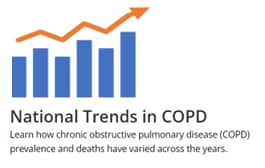Indicator Definitions – Chronic Obstructive Pulmonary Disease
Related Pages

Major risk factors for COPD include tobacco use, occupational and environmental exposures as well as genetic predisposition and respiratory infections. Although there is no cure for COPD, it can be treated. The COPD National Action Plan provides a comprehensive framework for what federal and nonfederal partners, patients and families, healthcare providers, academia, and the healthcare industry can do to build awareness of COPD and support prevention, early diagnosis, treatment, and management strategies.
Visit Chronic Obstructive Pulmonary Disease (COPD) | CDC for more information about this condition.
Definition Details
| Population: | All adults |
| Numerator: | Adults who report having ever been told by a doctor, nurse, or other health professional they had chronic obstructive pulmonary disease (COPD), emphysema, or chronic bronchitis. |
| Denominator: | All adults |
| Measure: | Prevalence (crude and age-adjusted) |
| Time Period of Case Definition: | Lifetime |
| Summary: | In 2021, more than 15 million Americans (6.4%) reported that they have been diagnosed with COPD.¹ Major risk factors include tobacco smoking, occupational and environmental exposures, respiratory infections, and genetics.2 Although there is no cure for COPD, it can be treated and managed to slow declining lung function, improve exercise tolerance, and prevent and treat exacerbations.2 |
| Notes: | The indicator is based on being diagnosed by a physician and respondent recall of the diagnosis and may underestimate the true prevalence. |
| Data Source: | Behavioral Risk Factor Surveillance System (BRFSS) |
| Related Objectives or Recommendations: | None |
| Related CDI Topic Area: | None |
| Reference 1: | BRFSS Web Enabled Analysis Tool. Centers for Disease Control and Prevention. Accessed May 3, 2023. https://nccd.cdc.gov/weat/#/ |
| Reference 2: | Agustí A, Celli BR, Criner GJ, et al. Global Initiative for Chronic Obstructive Lung Disease 2023 Report: GOLD Executive Summary. Am J Respir Crit Care Med. 2023;207(7):819-837. doi:10.1164/rccm.202301-0106PP |
| Population: | All adults |
| Numerator: | Adults who report current smoking and having ever been told by a doctor, nurse, or other health professional they had chronic obstructive pulmonary disease (COPD), emphysema, or chronic bronchitis. |
| Denominator: | Adults who report ever having physician-diagnosed COPD, emphysema, or chronic bronchitis. |
| Measure: | Prevalence (crude and age-adjusted) |
| Time Period of Case Definition: | Lifetime (COPD); current smoking. |
| Summary: | In 2021, more than 15 million Americans (6.4%) reported that they have been diagnosed with COPD.¹ Among those diagnosed with COPD, 34.5% reported they were current smokers. ¹ Elimination of tobacco use or exposure may be the most effective way to reduce COPD because almost 80% of COPD deaths are attributable to smoking.2 Smoking cessation is key to the prevention and management of COPD.3 |
| Notes: | Because COPD is a chronic disease, years might pass before changes in behavior or clinical practice affect population prevalence. |
| Data Source: | Behavioral Risk Factor Surveillance System (BRFSS) |
| Related Objectives or Recommendations: | None |
| Related CDI Topic Area: | None |
| Reference 1: | BRFSS Web Enabled Analysis Tool. Centers for Disease Control and Prevention. Accessed May 3, 2023. https://nccd.cdc.gov/weat/#/ |
| Reference 2: | Centers for Disease Control and Prevention. Smoking-attributable mortality, years of potential life lost, and productivity losses—United States, 2000-2004. MMWR. 2008;57(45):1226-1228. |
| Reference 3: | Agustí A, Celli BR, Criner GJ, et al. Global Initiative for Chronic Obstructive Lung Disease 2023 Report: GOLD Executive Summary. Am J Respir Crit Care Med. 2023;207(7):819-837. doi:10.1164/rccm.202301-0106PP |
| Population: | Medicare beneficiaries aged 65 years and older |
| Numerator: | Hospitalizations with any diagnosis of ICD-10-CM codes J40-44 among Medicare-eligible resident persons aged 65 years and older. |
| Denominator: | Residents 65 years and older who were eligible for Medicare Part A benefits on July 1 of the calendar year. |
| Measure: | Annual number of hospitalizations and hospitalization rates (crude and age-adjusted) [cases per 1,000] |
| Time Period of Case Definition: | Calendar year |
| Summary: | In 2020, there were 247,314 (82.92 per 1,000 Medicare enrollees aged ≥ 65 years) hospitalizations with COPD as any diagnosis.1 In addition, COPD coexists with other conditions, including cardiovascular disease, diabetes, and other respiratory diseases such as pneumonia, that have high hospitalization rates.2 Risk factors for COPD-related hospitalization include patients with COPD who have a past history of similar events, severe airflow limitation, poor health status, increased age, presence of emphysema, leukocytosis,3 poor health-related quality of life and lack of regular physical activity.4 Disease-management programs, in addition to pharmacologic or surgical interventions, have been shown to reduce hospitalization among patients with severe COPD at risk for acute exacerbations of COPD.5 |
| Notes: | Multiple admissions for an individual patient can falsely elevate the number of persons with COPD. Medicare claims records cannot identify incident (new) hospitalizations for COPD. |
| Data Source: | Centers for Medicare and Medicaid Services (CMS) Part A claims data |
| Related Objectives or Recommendations: | Healthy People 2030 objective: RD-04. Reduce hospitalizations for chronic obstructive pulmonary disease (COPD) (developmental). |
| Related CDI Topic Area: | Older adults |
| Reference 1: | National Center for Chronic Disease Prevention and Health Promotion. Chronic Disease Indicators. Centers for Disease Control and Prevention, US Dept of Health and Human services; Accessed March 9, 2023. https://www.cdc.gov/cdi/ |
| Reference 2: | Agustí A, Celli BR, Criner GJ, et al. Global Initiative for Chronic Obstructive Lung Disease 2023 Report: GOLD Executive Summary. Am J Respir Crit Care Med. 2023;207(7):819-837. doi:10.1164/rccm.202301-0106PP |
| Reference 3: | Müllerova H, Maselli DJ, Locantore N, et al. Hospitalized exacerbations of COPD: risk factors and outcomes in the ECLIPSE cohort. Chest. 2015;147(4):999-1007. doi: 10.1378/chest.14-0655 |
| Reference 4: | Bahadori K, FitzGerald JM. Risk factors of hospitalization and readmission of patients with COPD exacerbation–systematic review. Int J Chron Obstruct Pulmon Dis. 2007;2(3):241-51. |
| Reference 5: | Marchetti N, Criner GJ, Albert RK. Preventing acute exacerbations and hospital admissions in COPD. Chest. 2013;143(5):1444-1454. doi: 10.1378/chest.12-1801 |
| Population: | Medicare beneficiaries aged 65 years and older |
| Numerator: | Hospitalizations with first-listed diagnosis of ICD-10-CM codes J40–44 among Medicare-eligible resident persons aged 65 years and older. |
| Denominator: | Residents 65 years and older who were eligible for Medicare Part A benefits on July 1 of the calendar year. |
| Measure: | Annual number of hospitalizations and hospitalization rates (crude and age-adjusted) [cases per 1,000] |
| Time Period of Case Definition: | Calendar year |
| Summary: | In 2020, there were 165,248 (5.44 per 1,000 Medicare enrollees aged ≥ 65 years) hospitalizations with COPD as the first-listed diagnosis.1 Risk factors for hospitalization include patients with COPD who have a past history of similar events, severe of airflow limitation, poor health status, increased age, presence of emphysema, leukocytosis,2 poor health-related quality of life and lack of regular physical activity.3 Disease-management programs, in addition to pharmacologic and surgical interventions, have been shown to reduce hospitalization among patients with severe COPD at risk for acute exacerbations of COPD.4 |
| Notes: | Multiple admissions for an individual patient can falsely elevate the number of persons with COPD. Medicare claims records cannot identify incident (new) hospitalizations for COPD. Patients with COPD are often hospitalized with pneumonia and/or cardiovascular diseases, which may be the first-listed diagnosis. |
| Data Source: | Centers for Medicare and Medicaid Services (CMS) Part A claims data |
| Related Objectives or Recommendations: | Healthy People 2030 objective: RD-04. Reduce hospitalizations for chronic obstructive pulmonary disease (COPD) (developmental). |
| Related CDI Topic Area: | Older adults |
| Reference 1: | National Center for Chronic Disease Prevention and Health Promotion. Chronic Disease Indicators. Centers for Disease Control and Prevention, US Dept of Health and Human services; Accessed March 9, 2023. https://www.cdc.gov/cdi/ |
| Reference 2: | Müllerova H, Maselli DJ, Locantore N, et al. Hospitalized exacerbations of COPD: risk factors and outcomes in the ECLIPSE cohort. Chest. 2015;147(4):999-1007. doi: 10.1378/chest.14-0655 |
| Reference 3: | Bahadori K, FitzGerald JM. Risk factors of hospitalization and readmission of patients with COPD exacerbation–systematic review. Int J Chron Obstruct Pulmon Dis. 2007;2(3):241-51. |
| Reference 4: | Marchetti N, Criner GJ, Albert RK. Preventing acute exacerbations and hospital admissions in COPD. Chest. 2013;143(5):1444-1454. doi: 10.1378/chest.12-1801 |
| Population: | Adults aged 45 years and older |
| Numerator: | Deaths with International Classification of Diseases (ICD)-10 Code J40–J44 as underlying cause death among adults aged 45 years and older. |
| Denominator: | Midyear population of adults aged 45 years and older. |
| Measure: | Mortality rate (crude and age-adjusted); number [cases per 100,000] |
| Time Period of Case Definition: | Calendar year |
| Summary: | Chronic obstructive pulmonary disease (COPD) accounts for the majority of deaths from chronic lower respiratory diseases, the sixth leading cause of death in the United States in 2021.1 COPD is a progressive disease in which the body becomes less able to take in enough oxygen as airflow is obstructed;2 the obstruction of airflow is associated with increased mortality.3 Early diagnosis and effective management and treatment can help to reduce the risk of premature mortality.4,5 |
| Notes: | Because COPD is a chronic disease, years might pass before changes in behavior or clinical practice affect population mortality. Other comorbid conditions such as cardiovascular disease may displace COPD as the underlying cause of death that is reported on the death certificate.6,7 |
| Data Source: | National Vital Statistics System (NVSS) |
| Related Objectives or Recommendations: | Healthy People 2030 objective: RD-05. Reduce deaths from chronic obstructive pulmonary disease (COPD) among adults |
| Related CDI Topic Area: | Older adults |
| Reference 1: | Centers for Disease Control. CDC WONDER. Underlying Cause of Death, 2018-2021. Accessed May 1, 2023. https://wonder.cdc.gov/ucd-icd10-expanded.html |
| Reference 2: | Celli BR, MacNee W, et al. Standards for the diagnosis and treatment of patients with COPD: a summary of the ATS/ERS position paper. Eur Respir J. 2004;23(6):932-46. doi: 10.1183/09031936.04.00014304 |
| Reference 3: | Berry CE, Wise RA. Mortality in COPD: causes, risk factors, and prevention. COPD. 2010;7(5):375-82. doi: 10.3109/15412555.2010.510160 |
| Reference 4: | Antoniu SA. Descriptors of dyspnea in obstructive lung diseases. Multidiscip Respir Med. 2010;30:216–9. |
| Reference 5: | Agustí A, Celli BR, Criner GJ, et al. Global Initiative for Chronic Obstructive Lung Disease 2023 Report: GOLD Executive Summary. Am J Respir Crit Care Med. 2023;207(7):819-837. doi:10.1164/rccm.202301-0106PP |
| Reference 6: | Hansell AL, Walk JA, Soriano JB. What do chronic obstructive pulmonary disease patients die from? A multiple cause coding analysis. Eur Respir J. 2003;22:809-814. |
| Reference 7: | Jensen HH, Godtfredsen NS, Lange P, Vestbo J. Potential misclassification of death from COPD. Eur Resp J. 2006;28:781-785. |
| Population: | Adults aged 45 years and older |
| Numerator: | Deaths with International Classification of Diseases (ICD)-10 Code J40–J44 as either underlying or contributing cause of death among adults aged 45 years and older. |
| Denominator: | Midyear resident population aged 45 years and older. |
| Measure: | Mortality rate (crude and age-adjusted); number [cases per 100,000] |
| Time Period of Case Definition: | Calendar year |
| Summary: | Chronic obstructive pulmonary disease (COPD) accounts for the majority of deaths from chronic lower respiratory diseases, the sixth leading cause of death in the United States in 2021.1 Because COPD often coexists with other diseases that may significantly influence patient outcomes,2 it is important to assess mortality from COPD as a contributing, as well as underlying, cause of death. COPD is a progressive disease in which the body becomes less able to take in enough oxygen as airflow is obstructed;3 the obstruction of airflow is associated with increased mortality.4 Early diagnosis and effective management and treatment of COPD and its comorbidities can help to reduce the risk of premature mortality.2,5,6 |
| Notes: | Because COPD is a chronic disease, years might pass before changes in behavior or clinical practice affect population mortality. |
| Data Source: | National Vital Statistics System (NVSS) |
| Related Objectives or Recommendations: | Healthy People 2030 objective: RD-05. Reduce deaths from chronic obstructive pulmonary disease (COPD) among adults |
| Related CDI Topic Area: | None |
| Reference 1: | Centers for Disease Control. CDC WONDER. Underlying Cause of Death, 2018-2021. Accessed May 1, 2023. https://wonder.cdc.gov/ucd-icd10-expanded.html |
| Reference 2: | Vogelmeier CF, Criner GJ, Martinez FJ, et al. Global strategy for the diagnosis, management, and prevention of chronic obstructive lung disease 2017 report. Am J Respir Crit Care Med. 2017;195: 557–582. |
| Reference 3: | Celli BR, MacNee W, et al. Standards for the diagnosis and treatment of patients with COPD: a summary of the ATS/ERS position paper. Eur Respir J. 2004;23(6):932-46. doi: 10.1183/09031936.04.00014304 |
| Reference 4: | Berry CE, Wise RA. Mortality in COPD: causes, risk factors, and prevention. COPD. 2010;7(5):375-82. doi: 10.3109/15412555.2010.510160 |
| Reference 5: | Antoniu SA. Descriptors of dyspnea in obstructive lung diseases. Multidiscip Respir Med. 2010;30:216–9. |
| Reference 6: | Agustí A, Celli BR, Criner GJ, et al. Global Initiative for Chronic Obstructive Lung Disease 2023 Report: GOLD Executive Summary. Am J Respir Crit Care Med. 2023;207(7):819-837. doi:10.1164/rccm.202301-0106PP |
Additional Data Sources

| COPD Data and Statistics | CDC |

| PLACES: Local Data for Better Health | CDC |
Last Reviewed: July 24, 2023

